Graham Reid | | 4 min read
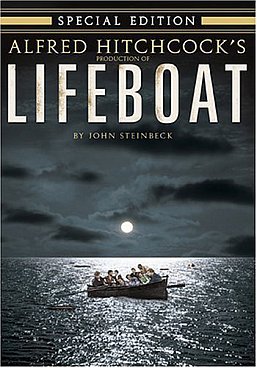
With the remarkable story of survival at sea by the Salvadoran fisherman Jose Alvarenga – more than a year in an open boat across the Pacific – the new Robert Redford film All is Lost could not be more timely.
In it Redford plays an unnamed lone sailor whose yacht collides with a shipping container and he is adrift and sinking. Critics are hailing it as one of Redford's greatest roles – he is the sole character on screen and there is little dialogue – while others are noting that as far back as the great Jeremiah Johnson in the early Seventies (where Redford played a reclusive and often mute mountain man) the actor was capable of creating a cinematic presence with minimal on-screen support.
But Alvarenga's story and Redford's All is Lost also bring to mind one of the great films of survival at sea, the human drama of Alfred Hitchcock's Lifeboat.
Released in 1944, Lifeboat was Hitchcock’s war time parable. The movie starts, after a passenger carrying freighter is torpedoed by a German U-boat and we are introduced to the survivors as they gradually assemble on the small lifeboat.
The last to arrive is a German from the sub also destroyed after an explosion and the German is taken on board as a prisoner of war. The survivors spend much of their time arguing and playing cards, never collectively getting it together . . . which leads the way for the resourceful, skilled German Willi to gradually take control. Hitchcock called the boat a “microcosm of the war”, the seven squabbling survivors representing the disorganized Allies.
As Hitchcock told the director Francois Truffaut. “So here was a statement telling the democracies to put their differences aside temporally and to gather their forces to concentrate on the common enemy, whose strength was precisely derived from a spirit of unity and determination.”
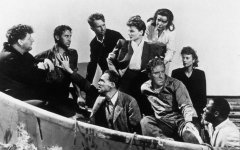 We
learn more about the characters through close ups. For example Willi
has a certain charm and sophistication in line with many of
Hitchcock’s villains. He’s the former commander of the U-Boat,
speaks several languages and puts his skills as a surgeon to good use
amputating the gangrened leg of one his fellow passengers. And we
could be lead, like the characters, into thinking maybe Willi isn’t
such a bad guy. But through a series of close ups we see he derives
his stamina and strength not from superhuman powers but from a secret
stash of water, and he has a concealed compass which he uses to
navigate the lifeboat towards a German supply ship.
We
learn more about the characters through close ups. For example Willi
has a certain charm and sophistication in line with many of
Hitchcock’s villains. He’s the former commander of the U-Boat,
speaks several languages and puts his skills as a surgeon to good use
amputating the gangrened leg of one his fellow passengers. And we
could be lead, like the characters, into thinking maybe Willi isn’t
such a bad guy. But through a series of close ups we see he derives
his stamina and strength not from superhuman powers but from a secret
stash of water, and he has a concealed compass which he uses to
navigate the lifeboat towards a German supply ship.
If that wasn’t enough, we get a big visual clue when a slow shadow slowly passes across Willi’s face, signifying his shady nature.
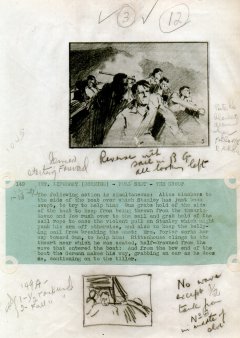 In
keeping with the minimalist single setting Lifeboat – from a story
by John Steinbeck – consists of three basic elements; the sea, the
boat and the characters.
In
keeping with the minimalist single setting Lifeboat – from a story
by John Steinbeck – consists of three basic elements; the sea, the
boat and the characters.
The sea is a moody presence throughout, sometimes calm and benign, at other times angry and threatening, aiding the death of two characters and nearly killing off a third during a storm.
Lifeboat was shot in a studio; a large tank of water was the stand-in for the ocean. The water’s performance was controlled by releasing additional water from four separate tanks, into the main tank, via chutes. The storyboards for Lifeboat (which you can see at the Alfred Hitchcock Wiki) show Hitchcock pre-planned the synchronization of waves with the storyline, in similar fashion to working out the placement of actors in each scene.
As with All is Lost, Lifeboat is an exercise in stripped-down cinema, reduced to a single-setting on a small boat in the middle of the ocean. Hitchcock repeated this single-setting theme in Dial M for Murder, Rope and Rear Window. Although the latter movies all featured characters confined to small apartments, the idea is the same, people physically trapped with little chance of getting away from their predicament.
In broader terms, confinement as a theme runs throughout Hitchcock’s work.
The climactic scene in The Birds when Melanie Daniels is attacked by vicious mob of birds, takes place in a small bedroom, Daniels pushed up, against a door, unable to escape. Psycho's Norman Bates may not be trapped in a small space but he is locked into what, on the surface, appears to be a dull routine revolving round his mother and the motel. As he says to the fated Marion Crane, “We are all in our private traps, clamped in them. And none of us can ever get out.”
 Four
boats played the singular lifeboat; two for rehearsals and filming
and one cut in half, the other lengthways, to accommodate the
movement of cameras. The small boat didn’t leave a lot of room for
the eight actors playing the survivors. But this works to the movie’s
favour increasing our (the audience) sense of sweaty confinement
watching the characters crammed into a small space. We also get to
share with the characters the same limited point of view in and
around the boat because Hitchcock – perhaps as a technical
challenge to himself – decided to never let the camera stray from
the inside of the boat.
Four
boats played the singular lifeboat; two for rehearsals and filming
and one cut in half, the other lengthways, to accommodate the
movement of cameras. The small boat didn’t leave a lot of room for
the eight actors playing the survivors. But this works to the movie’s
favour increasing our (the audience) sense of sweaty confinement
watching the characters crammed into a small space. We also get to
share with the characters the same limited point of view in and
around the boat because Hitchcock – perhaps as a technical
challenge to himself – decided to never let the camera stray from
the inside of the boat.
For a brief moment you can forget the storyline, when Hitchcock makes his trademark cameo appearing on the back of a newspaper, in an ad for a weight reduction product.
Other than that, there is little in the way of distractions, not even a musical score to heighten the emotions at key points in the story.
For the most part, we are stuck on the boat with the characters; it’s lonely, isolated and cramped. But at least we know not to trust Willi.
Sarah Jane Rowland is a writer who lives in Auckland, works in a library and her not-so secret passion is film. She is well read and well viewed. Her previous contributions to Other Voices Others Rooms are here.
Other Voices Other Rooms is an opportunity for Elsewhere readers to contribute their ideas, passions, interests and opinions about whatever takes their fancy. Elsewhere welcomes travel stories, think pieces, essays about readers' research or hobbies etc etc. Nail it in 1000 words of fewer and contact graham.reid@elsewhere.co.nz.
See here for previous contributors' work. It is wide-ranging

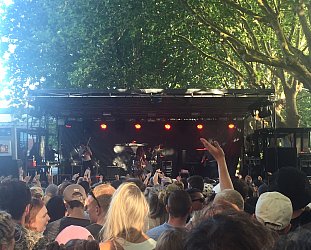

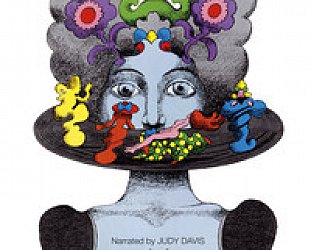
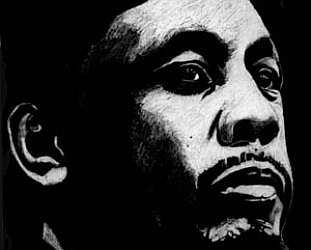
post a comment